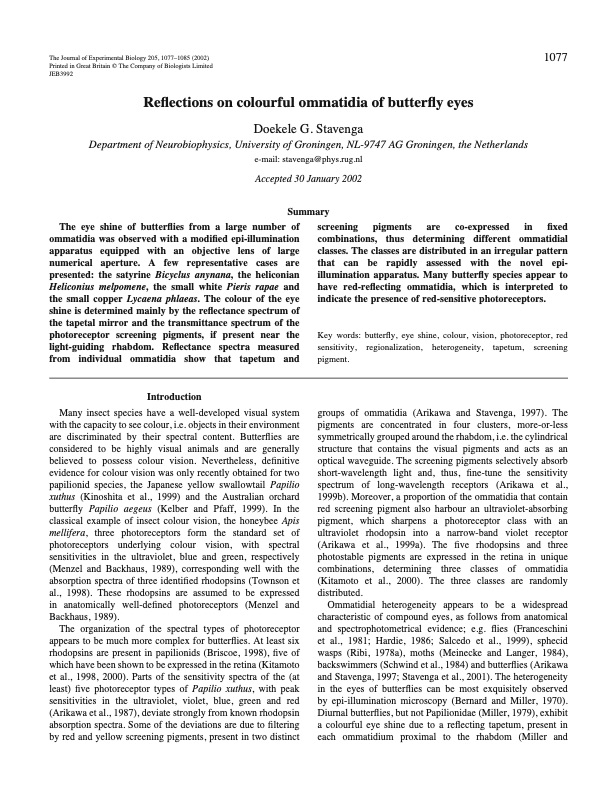
PDF Publication Title:
Text from PDF Page: 001
The Journal of Experimental Biology 205, 1077–1085 (2002) 1077 Printed in Great Britain © The Company of Biologists Limited JEB3992 Reflections on colourful ommatidia of butterfly eyes Doekele G. Stavenga Department of Neurobiophysics, University of Groningen, NL-9747 AG Groningen, the Netherlands e-mail: stavenga@phys.rug.nl Accepted 30 January 2002 Summary The eye shine of butterflies from a large number of ommatidia was observed with a modified epi-illumination apparatus equipped with an objective lens of large numerical aperture. A few representative cases are presented: the satyrine Bicyclus anynana, the heliconian Heliconius melpomene, the small white Pieris rapae and the small copper Lycaena phlaeas. The colour of the eye shine is determined mainly by the reflectance spectrum of the tapetal mirror and the transmittance spectrum of the photoreceptor screening pigments, if present near the light-guiding rhabdom. Reflectance spectra measured from individual ommatidia show that tapetum and screening pigments are co-expressed in fixed combinations, thus determining different ommatidial classes. The classes are distributed in an irregular pattern that can be rapidly assessed with the novel epi- illumination apparatus. Many butterfly species appear to have red-reflecting ommatidia, which is interpreted to indicate the presence of red-sensitive photoreceptors. Key words: butterfly, eye shine, colour, vision, photoreceptor, red sensitivity, regionalization, heterogeneity, tapetum, screening pigment. Introduction Many insect species have a well-developed visual system with the capacity to see colour, i.e. objects in their environment are discriminated by their spectral content. Butterflies are considered to be highly visual animals and are generally believed to possess colour vision. Nevertheless, definitive evidence for colour vision was only recently obtained for two papilionid species, the Japanese yellow swallowtail Papilio xuthus (Kinoshita et al., 1999) and the Australian orchard butterfly Papilio aegeus (Kelber and Pfaff, 1999). In the classical example of insect colour vision, the honeybee Apis mellifera, three photoreceptors form the standard set of photoreceptors underlying colour vision, with spectral sensitivities in the ultraviolet, blue and green, respectively (Menzel and Backhaus, 1989), corresponding well with the absorption spectra of three identified rhodopsins (Townson et al., 1998). These rhodopsins are assumed to be expressed in anatomically well-defined photoreceptors (Menzel and Backhaus, 1989). The organization of the spectral types of photoreceptor appears to be much more complex for butterflies. At least six rhodopsins are present in papilionids (Briscoe, 1998), five of which have been shown to be expressed in the retina (Kitamoto et al., 1998, 2000). Parts of the sensitivity spectra of the (at least) five photoreceptor types of Papilio xuthus, with peak sensitivities in the ultraviolet, violet, blue, green and red (Arikawa et al., 1987), deviate strongly from known rhodopsin absorption spectra. Some of the deviations are due to filtering by red and yellow screening pigments, present in two distinct groups of ommatidia (Arikawa and Stavenga, 1997). The pigments are concentrated in four clusters, more-or-less symmetrically grouped around the rhabdom, i.e. the cylindrical structure that contains the visual pigments and acts as an optical waveguide. The screening pigments selectively absorb short-wavelength light and, thus, fine-tune the sensitivity spectrum of long-wavelength receptors (Arikawa et al., 1999b). Moreover, a proportion of the ommatidia that contain red screening pigment also harbour an ultraviolet-absorbing pigment, which sharpens a photoreceptor class with an ultraviolet rhodopsin into a narrow-band violet receptor (Arikawa et al., 1999a). The five rhodopsins and three photostable pigments are expressed in the retina in unique combinations, determining three classes of ommatidia (Kitamoto et al., 2000). The three classes are randomly distributed. Ommatidial heterogeneity appears to be a widespread characteristic of compound eyes, as follows from anatomical and spectrophotometrical evidence; e.g. flies (Franceschini et al., 1981; Hardie, 1986; Salcedo et al., 1999), sphecid wasps (Ribi, 1978a), moths (Meinecke and Langer, 1984), backswimmers (Schwind et al., 1984) and butterflies (Arikawa and Stavenga, 1997; Stavenga et al., 2001). The heterogeneity in the eyes of butterflies can be most exquisitely observed by epi-illumination microscopy (Bernard and Miller, 1970). Diurnal butterflies, but not Papilionidae (Miller, 1979), exhibit a colourful eye shine due to a reflecting tapetum, present in each ommatidium proximal to the rhabdom (Miller andPDF Image | Reflections on colourful ommatidia of butterfly eyes

PDF Search Title:
Reflections on colourful ommatidia of butterfly eyesOriginal File Name Searched:
butterfly-eyes.pdfDIY PDF Search: Google It | Yahoo | Bing
Cruise Ship Reviews | Luxury Resort | Jet | Yacht | and Travel Tech More Info
Cruising Review Topics and Articles More Info
Software based on Filemaker for the travel industry More Info
The Burgenstock Resort: Reviews on CruisingReview website... More Info
Resort Reviews: World Class resorts... More Info
The Riffelalp Resort: Reviews on CruisingReview website... More Info
| CONTACT TEL: 608-238-6001 Email: greg@cruisingreview.com | RSS | AMP |